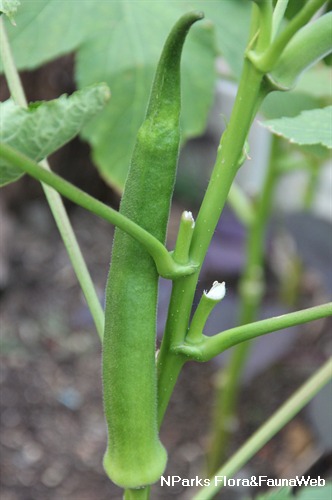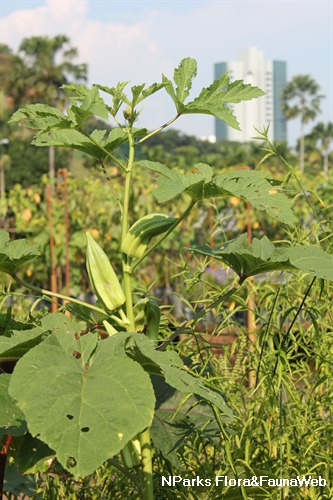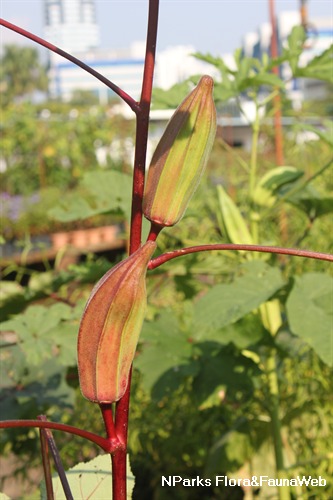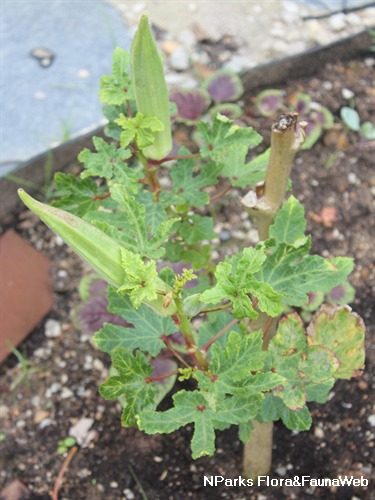
Back
Abelmoschus esculentus (L.) Moench
| Family Name: | Malvaceae |
| Synonyms: | Hibiscus esculentus |
| Common Name: | Lady's Fingers, Okra, Gumbo, Bendi, 咖啡黄葵, 黄苏葵, 黄秋葵, 羊角豆 |
The unripe fruit of Lady’s Finger is a popular vegetable in many cuisines which has a mucilaginous texture.
Name
Classifications and Characteristics
| Plant Division | Angiosperms (Flowering Seed Plants) (Dicotyledon) |
|---|---|
| Plant Growth Form | Herbaceous Plant |
| Lifespan (in Singapore) | Annual |
| Mode of Nutrition | Autotrophic |
| Plant Shape | Shrubby |
| Maximum Height | 1 m to 1.8 m |
Biogeography
| Native Distribution | Africa |
|---|---|
| Preferred Climate Zone | Tropical |
Description and Ethnobotany
| Growth Form | Erect, annual herb up to 1.8m tall (occasionally up to 4 m tall). |
|---|---|
| Foliage | Leaves velvety, palmately lobed. |
| Stems | Round, succulent stem. |
| Flowers | Yellow and Hibiscus-like, pollinated by bees. |
| Fruit | Dehiscent capsules. Young fruits green, covered by fine downy hairs, containing edible white seeds covered in mucilage; Mature fruits brown, fibrous tough, splitting open to disperse black seeds. |
| Cultivation | Prefers well-drained, fertile soils. Can be planted into the ground, or in pots and root-control bags. The period from sowing to first harvest is 47-97 days. Propagate by seeds - let fruit pods dry on plant, before collecting seeds. Caution: Stems and leaves are covered with slighly prickly hairs that might cause irritation to individuals with sensitive skin. Handle with gloves, if necessary. |
| Etymology | Genus epithet 'Abelmoschus' means 'source of musk', describing how some members of the genus (eg. Abelmoschus moschatus) are cultivated for their musk-scented seeds, which are used in perfumes and medicines. Species epithet 'esculentus' means 'edible', a reference to the young fruits. |
| Ethnobotanical Uses | Edible Plant Parts : Edible Fruits, Edible Leaves, Edible Flowers, Edible Seeds Food (Fruit or Vegetable): Young tender fruits eaten fresh or cooked as vegetable. Harvest pods within 1 week of flower pollination - look for pods with tips that snap and not bend upon pressure. Mucilage used to thicken stews, soups and Cajun gumbo. Leaves, flower buds and flowers also eaten as vegetable. Seeds are stimulant, roasted and grinded for use as non-caffeinated substitute for coffee. (Herb or Spice) Medicinal: Mucilagenous roots used to treat to treat syphillis, cuts, wounds and boils. Timber & Products: Stem fibres harvested for making jute, paper and textiles. |
Landscaping Features
| Landscaping | Commonly planted in home, school and economic gardens for the edible fruits. Giant fruit and red fruit cultivars (both with edible fruits) also available, usually cultivated for culinary or educational purposes. |
|---|---|
| Landscape Uses | Small Gardens |
| Thematic Landscaping | Economic Garden |
| Usage Hazard - Cons | Spines/Thorns - Stem/Branch, Spines/Thorns - Leaf |
| Usage Hazard - Cons Remarks | Little hairs/spines on leaves and stems may cause skin irritation in some individuals. |
Fauna, Pollination and Dispersal
| Pollination Method(s) | Biotic (Fauna) (Insects (Bee)) |
|---|---|
| Seed or Spore Dispersal | Abiotic (Explosive Dehiscence) |
Plant Care and Propagation
| Light Preference | Full Sun |
|---|---|
| Water Preference | Moderate Water |
| Plant Growth Rate | Moderate |
| Rootzone Tolerance | Fertile Loamy Soils, Well-Drained Soils, Easy to Grow |
| Maintenance Requirements | Moderate |
| Potential Problems | Lady's Fingers is prone to being attacked by aphids, spider mites, whiteflies and root knot nematodes. To learn more about how to manage these pests and care for Lady's Fingers, please click on this NParks' link: NParks' Gardening Resources . |
| Propagation Method | Seed |
| Seed / Spore Germination Duration | 6 days to 7 days |
Foliar
| Foliage Retention | Evergreen |
|---|---|
| Mature Foliage Colour(s) | Green |
| Mature Foliage Texture(s) | Velvety / Furry / Tomentose, Spiny / Bristly / Stinging |
| Prominent Young Flush Colour(s) | Green |
| Foliar Modification | Prickle / Emergence (blade) |
| Foliar Type | Simple / Unifoliate |
| Foliar Arrangement Along Stem | Opposite |
| Foliar Attachment to Stem | Petiolate |
| Foliar Shape(s) | Non-Palm Foliage (Palmate) |
| Foliar Venation | Palmate |
| Foliar Margin | Palmately Lobed, Serrate / Toothed |
| Foliar Apex - Tip | Acute |
| Foliar Base | Cordate |
| Typical Foliar Area | Notophyll ( 20.25cm2 - 45 cm2 ) |
Non - Foliar and Storage
| Stem Type & Modification | Herbaceous |
|---|---|
| Root Type | Underground (Fibrous Root) |
Floral (Angiosperm)
| Flower & Plant Sexuality | Bisexual Flowers |
| Flower Colour(s) | Yellow / Golden |
|---|---|
| Flower Location | Terminal |
| Flower Symmetry | Radial |
| Individual Flower Shape | Funnelform / Funnel-shaped |
| Flowering Period | Free-Flowering |
| Flower Lifespan on Plant | 1 Day |
| Flowering Habit | Polycarpic |
Fruit, Seed and Spore
| Mature Fruit Colour(s) | Brown |
|---|---|
| Fruit Classification | Simple Fruit |
| Fruit Type | Dehiscent Dry Fruit , Capsule |
| Mature Seed Colour(s) | Black |
| Mature Seed Texture(s) | Smooth |
Image Repository
Others
| Master ID | 285 |
|---|---|
| Species ID | 1581 |
| Flora Disclaimer | The information in this website has been compiled from reliable sources, such as reference works on medicinal plants. It is not a substitute for medical advice or treatment and NParks does not purport to provide any medical advice. Readers should always consult his/her physician before using or consuming a plant for medicinal purposes. |















